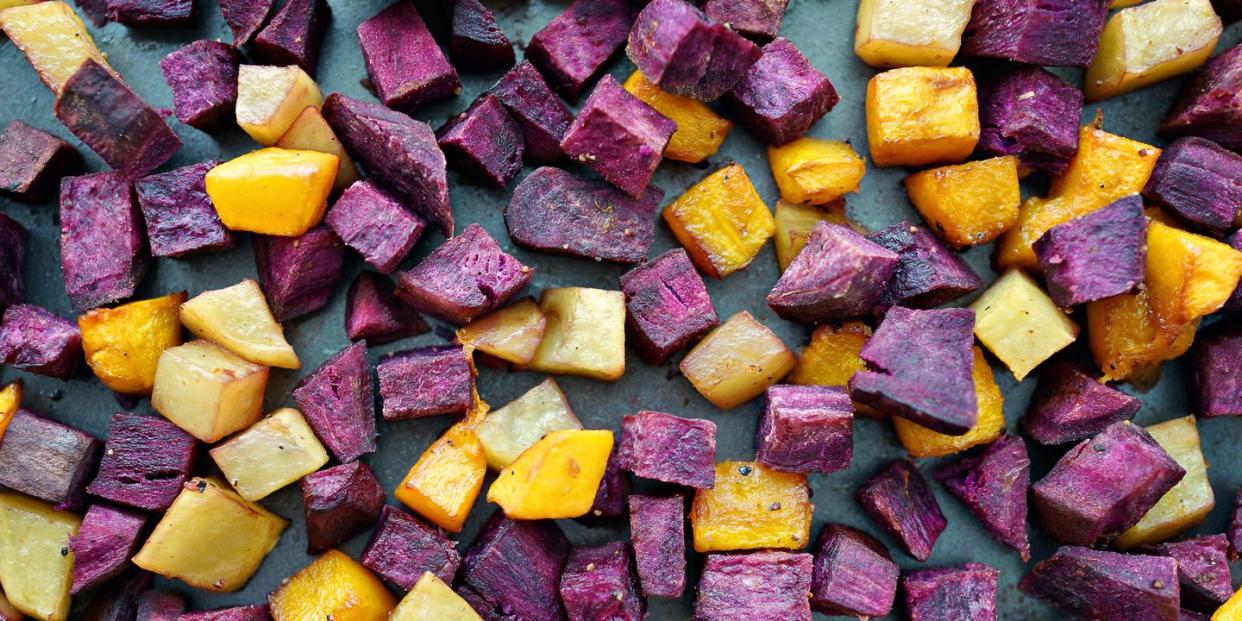Ube Is About to Be Your New Favorite Vegetable, Trust Us

You might have noticed more and more people at the grocery store buying bright purple potatoes. The trendy Willy Wonka-hued veggie is actually called ube. Thanks to the plant-based diet movement (and increasing access to fruits and vegetables from other parts of the world), the unique eat has made its way onto many a plate.
Since there’s only so much broccoli you can eat, adding funky new vegetables, like ube, to your diet makes getting your daily dose of the good stuff so much easier,
“Including a variety of fruits and vegetables makes meals more colorful and flavorful and provides all of the antioxidants and phytonutrients your body needs to thrive,” says dietitian Stephanie McKercher, R.D.N.
“Trying new foods is one of the best ways to keep boredom at bay and make healthy eating a regular part of your day-to-day lifestyle,” she adds.
Ready to step up your veggie game? Here’s what you need to know about ube.
What is ube, exactly?
Pronounced “ooh-bae,” ube is a purple spud related to the orange sweet potatoes you probably already eat regularly. Though similar to sweet taters in shape and size, ube has darker skin and deep purple flesh.
Though ube is originally native to the Philippines, it’s recently become an international sensation for its unique color and sweet, starchy flavor.
“Ube’s dark purple hue is definitely a fun and playful color to use in cooking and baking,” says dietitian Alanna Cabrero, R.D.N. “I’ve heard it defined as ‘colorful meets functional,’ and I agree.”
So ube is healthy, right?
Nutritionally, ube is pretty similar to other sweet potatoes. Both are great sources of fiber, vitamins, and minerals, and rich in antioxidants, which help protect against cellular damage in the body, says McKercher.
Here’s what you get in one serving (3.5 ounces) of cooked ube, per the USDA Nutrient Database:
Calories: 120
Fat: 0 grams
Carbs: 27 grams
Fiber: 4 grams
Protein: 1 gram
Sugar: 0 grams
Sodium: 10 mg
In addition to that, you also score 12 milligrams of vitamin C, plus small amounts of calcium, iron, and vitamin A.
“One of the main differences between sweet potatoes and ube are the type of antioxidants associated with their color,” says Cabrero. While the orange hue of sweet potatoes signals a rich carotenoid content, the purple hue of ube indicates lots of anthocyanins.
Anthocyanins, which are also responsible for the deep red and purple hues in berries, have been shown to help the body fight inflammation.
The purple yam is also a good source of complex carbohydrates, particularly resistant starch. “Resistant starch can act as a great prebiotic fiber,” Cabrero says. “Prebiotics help healthy bacteria in the gut flourish and protect our immune system.”
Ultimately, “both ube’s antioxidant profile and fiber content make it a great addition to an anti-inflammatory diet,” Cabrero says.
What does ube taste like?
Ube isn’t quite as over-the-top sweet as your regular old sweet potato. (It also doesn’t have as moist and soft a texture when cooked.)
A post shared by Cupcake Mama (@mycupcakemama) on Jan 20, 2020 at 9:21pm PST
According to McKercher, ube has a more of a mellow, nutty, vanilla-like flavor. Others, meanwhile, have described is as creamy and almost coconut-like.
Are ube and taro the same thing?
Perhaps you’ve heard of another purple root vegetable called taro that seems awfully similar to ube, and you wouldn’t be the only one to confuse the two. Though ube and taro can look somewhat similar on the outside, they’re definitely not the same thing.
While taro can take on a light purple hue, it’s typically mostly white or beige in color, says McKercher. Plus, because it has a more neutral taste, taro is more commonly used in savory dishes. Ube, with its sweet and nutty flavor, meanwhile, is more suited for desserts.
[Want to fly up hills? Climb! gives you the workouts and mental strategies to conquer your nearest peak.]
How to try ube for yourself.
Unlike sweet potatoes, you may have to hunt a little bit to find ube at the store. Though you may find the purple yams at your local organic market and health food stores like Whole Foods and Trader Joe’s, your best bet for finding whole ube (and ube products, like ube powder or extract) is to check out an Asian grocery store.
Once you’ve got your hands on some ube, its sweet flavor and creamy texture makes it a natural choice for treats like baked goods. (It’s often used in Filipino desserts, including muffins, cakes, cheesecakes, cookies, ice cream, and bubble tea.)
A post shared by Le Happy Eats | Food Blog (@lehappyeats) on Jan 20, 2020 at 10:53am PST
If you can’t find ube powder or jam, you can often use steamed and pureed ube in its place.
Cabrero recommends adding pureed ube to pancake or waffle batters and quick bread recipes. It also works well in pretty much any recipe that calls for pumpkin puree.
Ube isn’t only good for satisfying your sweet tooth, though. Of course, you can also bake, roast, and mash them, just like you would regular potatoes or sweet potatoes. (Check out this mashed purple yams with sesame brown butter recipe from The Endless Meal.)
Want to keep it super simple? Cabrero suggests roasting ube with avocado oil and pumpkin seeds or making ube fries in the air fryer.
You Might Also Like

